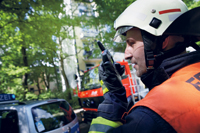|
TETRA originated within the halls of ETSI in the mid-1990s. What were the main reasons for creating the standard and when was the TETRA Association formed? Phil Kidner: There were lots of different stakeholders involved in the beginning. Some had the desire to make better use of spectrum; others were looking to develop new systems for a variety of applications and industries such as public safety and utilities. In addition, we had the Schengen* Agreement on open borders between all European countries, part of which was a police user requirement for a pan-European, cross-border communications system that could be used by the police and emergency services. The standard itself, designed to meet all the different requirements of all the different stakeholders, was written in the early to mid-’90s and the TETRA Association was formed in ’93–’94 to move it on. What are the main applications and markets currently using and adopting TETRA? Has this list changed PK: The biggest sector for TETRA over the years has been public safety. If you added up every terminal that had been deployed for TETRA around the world it would be between two and three million to date, with the public safety sector users having by far the biggest number. But if you add up the number of networks, transport is now the biggest sector, with networks in use at airports, on metro systems, for railways, on buses or by taxi companies. TETRA is now deployed in over 114 countries around the world. While it started life in Europe, which remains the region with the largest base of TETRA systems today, the fastest-growing markets are the Asia Pacific and South America. In fact, the Asia Pacific has 25 per cent of all the networks currently operating. Has the progress of TETRA through the 1990s and to this point in the new millennium met the expectations of all key stakeholders involved? Are there any new advances on the horizon – new data capabilities, for example – which make a TETRA Release 3 a likelihood any time soon? PK: The first systems went in at the turn of the century. In the UK that was the Airwave system, which began rolling out in 2000. There were a few in the late ’90s but 2000 was a big date in the TETRA world; and whilst ETSI delivered the standard, within that standard there were, as with every standard, lots of options. What the TETRA Association has been doing is two things: we have taken the standard and agreed amongst the TETRA community how it will best be implemented. We then have a testing and certification process that is run for us by a ministry of the Italian government to test all the equipment from different manufacturers for interoperability. Out of that process has come some firming-up and changes to the standard which have been fed back into ETSI, enabling them to keep the standard up to date. In addition, as people use the system, they continue to feed back new requirements. We have a process within the TETRA Association whereby feedback from existing users is assessed and passed to ETSI, if appropriate, so that suitable user inputs can be developed into the standard. In 2005, there was recognition that data rates could be improved and TETRA 2 including TEDS was standardized. We’re now seeing the first products for that being delivered in 2010. TEDS delivers a tenfold increase to TETRA’s data rates. All the while that’s happening, we are currently working with ETSI on the next evolution of TETRA – and that could be broadband TETRA, or TETRA interfacing to some other broadband technology like LTE. That work is happening today, and one of the reasons I believe there is a good future for TETRA is because of all the work we are doing to keep the standard up to date. Faith in the longevity of the standard is borne out by the unfolding scenario in Germany. We now have systems like the German BDBOS (the Federal Agency for Digital Radio of Security Authorities and Organizations – die Bundesanstalt für den Digitalfunk der Behörden und Organisationen mit Sicherheitsaufgaben) being deployed at the moment – that’s going to be the biggest network so far when it’s complete – and they are doing this clearly believing there is a future for TETRA for the next 10–15 years. BDBOS is Germany’s Airwave equivalent, their national public safety system, but it will be twice the size of the UK network when it’s completed in the next couple of years.
|

